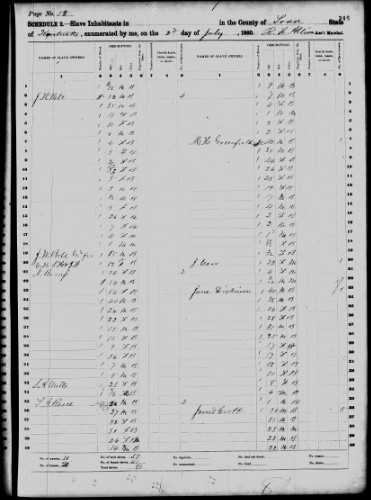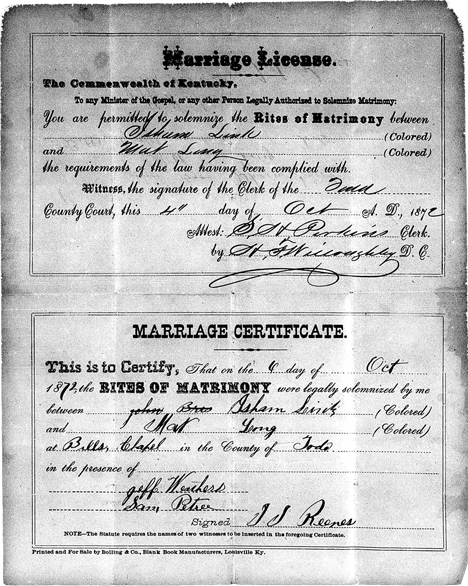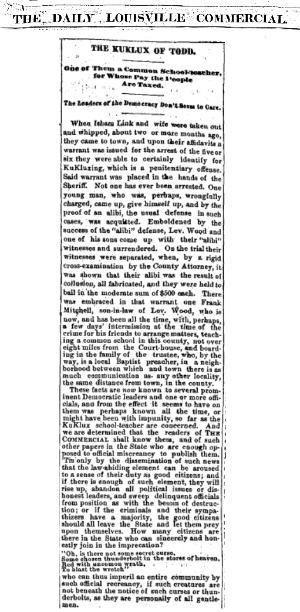


Page from the 1860 Census slave schedule for Todd County, KY, listing the people owned by John W. Bell
July 2, 1860
Fearlessly Asserting Legal Rights:
Isham and Mattie Link
Isham and Mattie Link, an African American couple from Todd County, were the target of vicious KKK violence in 1874, in part because of their willingness to assert their basic legal rights. Mattie’s children were kidnapped and Isham was murdered in a KKK raid that gained national attention (New York Times, November 29, 1874), and in response to each incident Mattie turned to the law to (attempt to) seek justice.
Isham and Mattie Marry
Isham Link, a black man born into slavery around 1852, worked as a farm laborer for John W. Bell according to the 1870 Census. Bell, a prosperous farmer, reported owning 17 people, including one 8-year-old boy, in 1860. This boy may have been Isham, as many people freed from slavery worked for their former owners. In any case, both Bell and Link lived in Fairview near Bell’s Chapel, a church founded by Bell’s Methodist minister father, Reverend Caleb Norris Bell, Jr. And, in the 1870 census, Link is enumerated only a few lines below his boss, Bell, suggesting that they were near neighbors.
While only 18 years of age in 1870, Isham was already a member of the Todd County militia. He was one of the first black men to enlist. After the Civil War and the end of slavery, the militia was sometimes called in to control racially-motivated violence, riots, and feuds.
Mattie Long, also born into slavery, was listed in the census as 16 in 1870, but perhaps was significantly older. She lived in Hopkinsville, 10 miles to the west of Fairview in neighboring Christian County, with her mother and family. They resided with, and were employed as servants by a wealthy tobacconist, James E. Jessup. Mattie was the mother of two young children, Harriet 7 and Anthony 10, both born into slavery and still held in slavery.
By October 1872, Isham Link and Mattie Long were married. The ceremony took place at Bell’s Chapel. The new Link family took up residence in a nearby cabin on a farm owned by Joel D. McCormick, a local saloon keeper, about two miles west of Elkton and not far from John W. Bell’s farm where Isham had previously worked.
Asserting Legal Rights
Mattie Link asserted her new legal rights against white men, and in doing so enraged the white men who were seeking to re-enslave her children by bonding them as apprentices. E. G. Wood and John Wood, both residents of Fairview, which straddled the boundary of Christian and Todd counties, probably owned Mattie before the Civil War. After the War ended, the Woods held onto Mattie’s two children, Harriet and Anthony. In the 1870 Census, Harriet and Anthony are listed in the Wood household, the only two black people in the household. To regain her children, Mattie sued both Woods.
Kentucky law gave unusual latitude to white men to bond children they once owned as apprentices, effectively continuing their enslavement. Legal challenges to bonding were difficult. Additionally, the court was not used to hearing African Americans testify — Kentucky finally granted African Americans the right to testify against white men in 1872, much later than most other states.
It was probably Monday June 8, 1874 (county court sessions in Kentucky were usually on the second Monday of the month), when the Todd County Court heard Mattie’s case and vacated the apprenticeship. The Lexington Daily Commercial explained what happened next:
The orders binding them [Mattie’s children] were so manifestly illegal that [E. G.] Wood made no defense, but was on hand with an armed mob with which, by force he took the children from their mother upon the public square immediately after the County Court had set aside the orders binding them and took one of them to Christian County.
Louisville Daily Commercial, July 4, 1874).
In response, Mattie again turned to the legal process. She “employed an attorney in Elkton, obtained a writ of habeas corpus and got possession of the one [child] left in Todd [County].” The Commercial explained that this use of the legal process “very much incensed the Woods hence the KuKluxing.” (Louisville Daily Commercial, July 4, 1874)
The Klan Attacks
On the night of Tuesday June 30, 1874, not long after Mattie Link prevailed in her habeas corpus suit, fifteen to twenty masked Klansmen broke into the Link’s cabin. Mattie was able to escape and ran toward the McCormick house. “Three or four” Klansmen caught her and “stamped her.” Joel D. McCormick rushed out of his house with his pistol and the masked men retreated. But nine other Klansmen seized Isham, stripped and whipped him, told him they would come again to whip his wife and kill her (The Louisville Daily Commercial, July 4, 1874).
Asserting Legal Rights, Again
After the June 30 attack, Isham and Mattie once again asserted their legal rights. They went together to Elkton, and both swore out an affidavit “for the arrest of the five or six they were able to certainly identify for KluKluxing, which is a penitentiary offense.” (The Louisville Daily Commercial, September 22, 1874). Included on the affidavit were E. G. Wood, his son, John Wood, and Fleming Wood.
The Klan Attacks, Again
Six weeks after the first attack, on August 20, 1874, a dozen or so Klansmen on horseback attacked the Links’ cabin. Isham was elsewhere, but Mattie was asleep inside. The Klansmen captured Mattie and “forced her to travel with them three miles” on the back of a Klansman’s horse to John Bells’ farm, where Isham once worked. Once there, the Klansmen forced Mattie “ show them where her husband was.” (The Louisville Courier Journal, August 31, 1874). By the end of the night, Isham and a young African American boy were dead (The Louisville Courier Journal, August 31, 1874; taken from the Elkton Witness, August 28, 1874).
The Legal System Fails the Links
A coroner’s court was held in Elkton and, for the fourth and final time, Mattie Link invoked the law. This time she testified against the white man — John Wood — who had participated in the false apprenticing of her two children, the kidnapping of one child, two Klan raids against her family, and the murder of her husband. She “swore before the coroner that she recognized John Wood. First, she recognized his voice, and then he lifted his mask and asked her if she knew him. She told him she did not, fearing she would be killed if she answered in the affirmative” (Elkton Witness, August 28, 1874).
The editor of the Witness grew cautious, recognizing the enormity of a black woman testifying against a white man in Kentucky in 1874. But, said Cox, it was “proper” to report this black testimony against a white man accused of terrorism and murder. For the doubtful reader, Cox added:
This fact is in testimony before the coroner. We have compiled the trove from testimony given before the coroner, Dr. W B Jefferson, and we believe we have omitted no important statement at all.
This is the only source of evidence or report in the case at all (Elkton Witness, August 28, 1874).
Mattie sought justice for her murdered husband and her lost child, bravely testifying in coroner’s court that she recognized John Wood from the raid. It would prove insufficient. The coroner’s ruling, quoted by Cox in his paper, was that:
Isham Link came to his death by pistol or gun shots, or both, on the 20th inst, fired at the hands of persons not known to them (the jury).
Elkton Witness, August 28, 1874.
Perhaps Cox inserted the parenthetical comment –“the jury”— into the text of the report to make it clear to his readers that he knew who the murders were and so did the jury.
Todd County begins to reject the KKK
Cox’s account of Mattie’s testimony and the coroner’s court ruling appeared in the Elkton Witness on Friday, August 28. In response, the next morning, Saturday, Elkton Sheriff James Christian assembled a posse “of the very best citizens of Elkton, some of the most influential men of the county” and led it to Fairview, and into the neighborhood where the murders had been committed, in an attempt to hold perpetrators accountable. (Elkton Witness, August 28, 1874)
No arrests were made and no evidence found. Still, Cox wrote, Elkton had done the right thing. It had “showed that it respects the reign of law, and its people are aiding in the execution of the law.” Cox added in his account of these exciting events a prophetic comment “the people are much excited, and know not where these things will end” (Elkton Witness, August 28, 1874).
Mattie Link: Another Forgotten Hero
Mattie Link (nee Long) is lost to us. We do not know whether she stayed in Todd County and changed her name, was murdered by the Woods who had gone unpunished for their earlier crimes against her and her family, or she simply moved on, cutting her losses from a county that refused, even a decade after the Civil War, to acknowledge her as a person rather than property.










